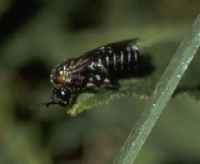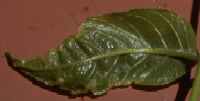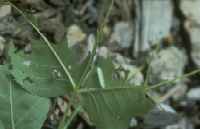by W.S. Cranshaw* (7/14)
Quick Facts…
- The green, worm-like larvae chew the leaves of ash trees in spring.
- Weather is the most important natural control. Late spring frosts and strong winds may kill large numbers.
- During the early stages of an infestation, larvae make small “pinhole” wounds in the interior of leaves.
- If necessary, brownheaded ash sawflies are easily controlled by almost any garden insecticide, including soaps. Many can also be dislodged by a strong jet of water from a hose.
In recent years the brownheaded ash sawfly, Tomostethus multicinctus, has become a common insect pest along the Front Range. It appeared in the Arkansas Valley area by the early 1980s. Since then, it has steadily expanded its range northward and now also occurs on the Western Slope. Given the rapidity of its spread, the insect apparently is a strong flier that can disperse long distances. It is native to the eastern United States, where it rarely causes concern.
Larvae damage ash trees by chewing the leaves in May and early June. The larvae are pale green ‘worms’ with some light banding. During outbreaks, they extensively defoliate the tree. This can cause significant stress to the tree, particularly when it occurs repeatedly. The worms can also be a nuisance when they wander from the tree and move to areas of loose soil, where they overwinter.

Figure 1: Brownheaded ash sawfly. |
Life History and Habits
The brownheaded ash sawfly spends the winter as a full-grown larva within a cocoon in soil around the base of previously infested ash trees. Pupation occurs in early spring. Adults are small, black, nonstinging wasps that typically emerge by late April.
During warm days, swarms of the wasps may appear around trees as they mate and lay eggs. The eggs are inserted into the edge of expanding leaves. This usually results in a slight distortion of the leaves.
Young larvae feed on the interior of leaves, producing small pinhole feeding wounds. As they get older, they feed extensively on leaves, avoiding only the main veins. During the late stages of development, defoliation can progress rapidly. However, injuries also subside quickly, as the insects usually become full-grown within two to three weeks after egg hatch.
During most years, the larvae are active during May. They become full-grown by early June. Full-grown larvae shed a papery larval skin that remains attached to the leaf. They drop to the ground and crawl into the soil, where they form protective cocoons. There is one generation per year. The larvae remain in the cocoons until the following season.

Figure 2: Distorted leaves from brownheaded ash sawfly egg laying. |

Figure 3: Brownheaded ash sawfly larva and characteristic feeding injury. |
Control of Brownheaded Ash Sawfly
Weather seems to be particularly important in their population cycles. One of the greatest checks is late spring frosts that kill the first flush of foliage — and with it, the early active stages of the insect.
Brownheaded ash sawflies are fairly delicate and strong winds can easily dislodge them from trees. Few larvae successfully re-establish themselves after being dislodged. During very heavy outbreaks, the insects can become so numerous that they eat all the foliage and many may starve to death.
In recent years, parasitic wasps have also been observed to attack sawfly pupae. These appear to be helping reduce the severity of the insect along the Front Range.
There are several considerations when deciding whether to control brownheaded ash sawflies. Established, healthy trees tolerate defoliation fairly well, particularly if it occurs infrequently. Trees benefit from control only if the insects threaten to remove at least 25 percent of the foliage. Trees that are repeatedly heavily defoliated, are in marginal health, or are suffering from other important stresses (e.g., bark beetles, borers, scale) will benefit most from treatment.
Also, because defoliation progresses rapidly, treatments are most useful if applied early in the infestation. To detect potential problems, watch for the pinhole injuries made by the young larvae.
If treatment is needed, the brownheaded ash sawflies are easily controlled. A strong jet of water from the hose can knock many larvae off a tree. Soapy water is effective if applied to the bodies of the larvae. They also are susceptible to most garden insecticides (e.g., carbaryl/Sevin, permethrin, spinosad) and are controlled with soil applications of the systemic insecticide imidacloprid. However, Bacillus thuringiensis (Dipel, Thuricide) and neem do not appear to be effective.
*W.S. Cranshaw, Colorado State University Extension entomologist and professor. 2/99. Revised 7/14.
Colorado State University, U.S. Department of Agriculture and Colorado counties cooperating. Extension programs are available to all without discrimination. No endorsement of products mentioned is intended nor is criticism implied of products not mentioned.
Go to top of this page.





